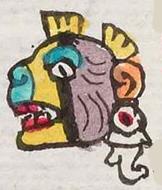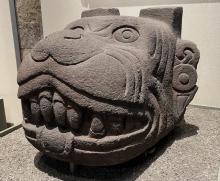Xolotl (Mdz13v)
This simplex glyph for Xolotl (the deity and/or ancestor-ruler that is typically presented as part human, part dog) is quite different from the other one we offer. This one is also outlined in black, but is painted with multiple colors. It is a head in profile facing to our left. It is a dog head with wrinkles that recall the anthropomorphic aging process. Further, the Mexican hairless dog called the xoloitzcuintli has wrinkles. There is a black line (face paint? a tattoo?) cutting the head in half vertically and running behind the one eye that we can see. The eye is white with a large black pupil. Above the eye is what may be a turquoise-colored eyebrow. On top of the head are two protrusions, squared off, and painted yellow. The face is largely painted yellow, too, but the nose is turquoise. The mouth is open and four of the teeth are painted red. The ear is painted the same tan-flesh tone as in the other xolotl sign we include in this database. Below the ear is a white earring. The top part of the earring consists of two concentric circles, the outer one being white and the inner one being black with red paint over it.
Stephanie Wood
In this simplex glyph for the deity Xolotl, the dog-like appearance and the colors are significant. The yellow, turquoise, white, and red are all referenced in the Florentine Codex (Book 8, Kings and Lords) in these descriptions: "The Xolotl head of yellow parrot feathers, with balls of quetzal feathers, was ornamented with gold. With it belonged a shirt of yellow parrot feathers with hawk scratch decorations in gold. The blue Xolotl head was ornamented with quetzal feathers and gold. With it belonged a blue shirt. The white Xolotl head was ornamented with quetzal feathers and gold. With it belonged a white shirt. The bright red Xolotl head was ornamented with quetzal feathers and gold; its shirt was likewise bright red." [Source: Fr. Bernardino de Sahagún, Florentine Codex: General History of the Things of New Spain; Book 8 -- Kings and Lords, no. 14, Part IX, eds. and transl. Arthur J. O. Anderson and Charles E. Dibble (Santa Fe and Salt Lake City: School of American Research and the University of Utah, 1951), 34.] This glyph also offers some overlap with representations of old men and therefore perhaps the ancestor-ruler of 200 years that Chimalpahin mentions, given the wrinkles (xolochtic).
Note the museum comparison image below with the prominent teeth, the lines of wrinkles on the face, and the ear ornament. From the angle of the photograph it is difficult to tell if the two rectangular protrusions at the top and back of the dog's head are solid or possibly have the cuts in them that are visible in the glyph. One thing this carving has that is different from this glyph is the protruding tongue.
The rectangular protrusions on the top of the Xolotl head are reminiscent of the similar shapes on the portrayals of sculptures of divine forces in some of the glyphs of the nenetl. (See below.)
Stephanie Wood
c. 1541, but by 1553 at the latest
Stephanie Wood
David Elliot
old men, aging, viejos, envejecimiento, dogs, perros, deidades, wrinkled, arrugado, ancestors, deities, divinities, divinidades, fuerzas divinas, rulers, canines, xiuhpohualli, año, turquesa, xihuitl
Xolotl. Museo Nacional de Antropología e Historia, Salón Mexica. Photograph by Stephanie Wood, 14 February 2023.

Xolotl, deity and/or ancestor-ruler, https://nahuatl.wired-humanities.org/content/Xolotl
xoloitzcuin(tli), a native Mexican nearly hairless dog, https://nahuatl.wired-humanities.org/content/xoloitzcuintli
xoloch(tic), wrinkled, https://nahuatl.wired-humanities.org/content/xolochtic
el ancestro o la deidad Xolotl
Stephanie Wood
Codex Mendoza folio 13 verso, https://digital.bodleian.ox.ac.uk/objects/2fea788e-2aa2-4f08-b6d9-648c00..., image 37 of 188.
The Bodleian Libraries, University of Oxford, hold the original manuscript, the MS. Arch. Selden. A. 1. This image is published here under the UK Creative Commons, “Attribution-NonCommercial-ShareAlike 3.0 License” (CC-BY-NC-SA 3.0).








